The Roman Forum, Colosseum, and Palatine Hill were the center for public and political life in ancient Rome. What exactly happened in these places that travelers are still drawn to visit over 2,700 years later? Whose footsteps are you walking in as you explore the Palatine Hill or walk through the forum? The ruins themselves are impressive, but they are only echoes of what daily life in ancient Rome was like.
The Colosseum
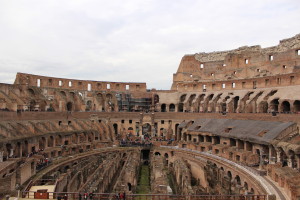 The largest amphitheater in the Roman world was built in just ten years, from 70 A.D to 80 A.D. Emperor Vespasian commissioned the amphitheater to be built where there was a giant, man-made lake from Nero’s Domus Aureus, or Golden House. Nero’s reign ended on a bad note due to some questionable decisions, including evicting Romans to build his own extravagant palace. Choosing this location to build a public building was Emperor Vespasian’s way of giving the space back to the people.
The largest amphitheater in the Roman world was built in just ten years, from 70 A.D to 80 A.D. Emperor Vespasian commissioned the amphitheater to be built where there was a giant, man-made lake from Nero’s Domus Aureus, or Golden House. Nero’s reign ended on a bad note due to some questionable decisions, including evicting Romans to build his own extravagant palace. Choosing this location to build a public building was Emperor Vespasian’s way of giving the space back to the people.
The ancient Romans would have known the Colosseum as the Flavian Amphitheater, named for Vespasian and the Flavian Dynasty he established. The name Colosseum possibly came from the proximity of the amphitheater to the huge statue, or Colossus, of the sun god.
The common belief is that the Colosseum regularly held fantastic gladiatorial fights to the death. However, the games were not very often and rarely resulted in death. For the most part, the action happened during festivals and on holidays. The rest of the year the 50,000 seats sat empty. When crowds did fill the arena, they expected to see an actual fight that was more of a theatrical performance than a true battle. Gladiators were highly skilled and well-trained, making them too big of an investment for their owners to lose in one fight. The crowd kept track of their favorite fighters, much like modern sports statistics, and knew exactly when a gladiator was performing well. The only deaths regularly occuring during gladiatorial games were of the exotic animals imported from around the empire that gladiators slaghtered in front of the crowd.
The Roman Forum
This large space, though it seems very open today, would have felt packed with large public buildings, temples, a surrounding portico, and all kinds of people. Once the work day began, men would 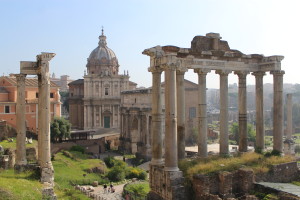 arrive in the forum to conduct their business. Some were bankers who spent their day weighing coins to look for fakes and listening to clients seeking loans. Others gathered here to buy and sell their wares. Politicians worked to promote themselves to an audience gathered around the rostra, the public speaking platform. Senators would convene in the curia to hold meetings. The forum was a lively, busy place.
arrive in the forum to conduct their business. Some were bankers who spent their day weighing coins to look for fakes and listening to clients seeking loans. Others gathered here to buy and sell their wares. Politicians worked to promote themselves to an audience gathered around the rostra, the public speaking platform. Senators would convene in the curia to hold meetings. The forum was a lively, busy place.
Not just adults gathered in the forum, but also students. Teachers would have their pupils gather around beneath the covered portico. There, young men of good status would learn about literature, public speaking, and arithmetic. They would write on wax tablets and sometimes even carve lines of epic poems, like Virgil’s Aeneid, into the wall.
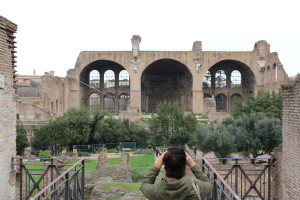 School and work were far from the only purposes of the forum. It was also a center for religious life. The Temple of the Vestal Virgins, which housed the eternal flame of Rome, was one of the most important of the many temples in the forum. Romans would also go to the forum to socialize. They would listen to whoever was speaking from the rostra or take a seat on the steps opposite and play the board game carved into the marble. The forum was as much of a space for work as it was for play.
School and work were far from the only purposes of the forum. It was also a center for religious life. The Temple of the Vestal Virgins, which housed the eternal flame of Rome, was one of the most important of the many temples in the forum. Romans would also go to the forum to socialize. They would listen to whoever was speaking from the rostra or take a seat on the steps opposite and play the board game carved into the marble. The forum was as much of a space for work as it was for play.
The Palatine Hill
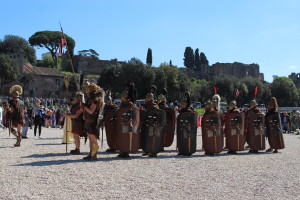 As Romans walked around the forum, you can easily imagine them glancing up at the Palatine Hill. Above them were the houses of the powerful, the ruling class. Living on the Palatine, these social elites wielded power over the rest of the Romans, illustrated by their physical height above the city.
As Romans walked around the forum, you can easily imagine them glancing up at the Palatine Hill. Above them were the houses of the powerful, the ruling class. Living on the Palatine, these social elites wielded power over the rest of the Romans, illustrated by their physical height above the city.
The most impressive would have been the Domus Augustana which was built during Domitian’s reign (81-92 A.D.) The structure itself was so impressive that succeeding Emperors chose to move in after their predecessors instead of building a new palace, as was typical before Domitian. Some of the most important rooms included the reception hall, where special guests would wait to be greeted by the emperor, and the dining hall. This room was not only massive, but had heated floors. The entire palace was coated in different marbles from across the empire.
T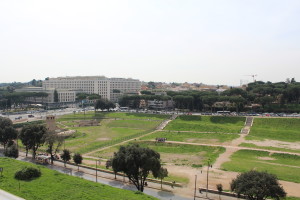 he view from the hill was equally as impressive as the houses that sat there. There were panoramic vistas of the city and an overlook of the Circus Maximus, Rome’s racetrack. The main purpose of this stadium was chariot racing where up to 250, 000 Romans would cheer on their favorite team—red, white, blue, or green.
he view from the hill was equally as impressive as the houses that sat there. There were panoramic vistas of the city and an overlook of the Circus Maximus, Rome’s racetrack. The main purpose of this stadium was chariot racing where up to 250, 000 Romans would cheer on their favorite team—red, white, blue, or green.
Today, visiting these sights is impressive, but it’s hard to visualize the daily life of the ancient Romans. It’s difficult to visualize rows upon rows of marble benches around the Colosseum or the special emperor’s box. And while you can walk through the Domus Augustana, grasping its true scale and majesty is difficult when we are left with one level of brick ruins and few accessible tunnels.
Thankfully, new technology combined with a passion for understanding the daily life of Ancient Rome has created a new way to visit these ancient monuments. Digital reconstructions and virtual reality are the latest in experiencing the past. LivItaly’s VR Tour can lead you through the Colosseum, Palatine Hill, and Forum, while letting you catch a glimpse of the daily life that once existed within the very ruins you visit.


Is this all true or not just asking to make sure because im using it for a project and all the stuff has to be true.
Hello Candice, Yes all of this info is true!
very good